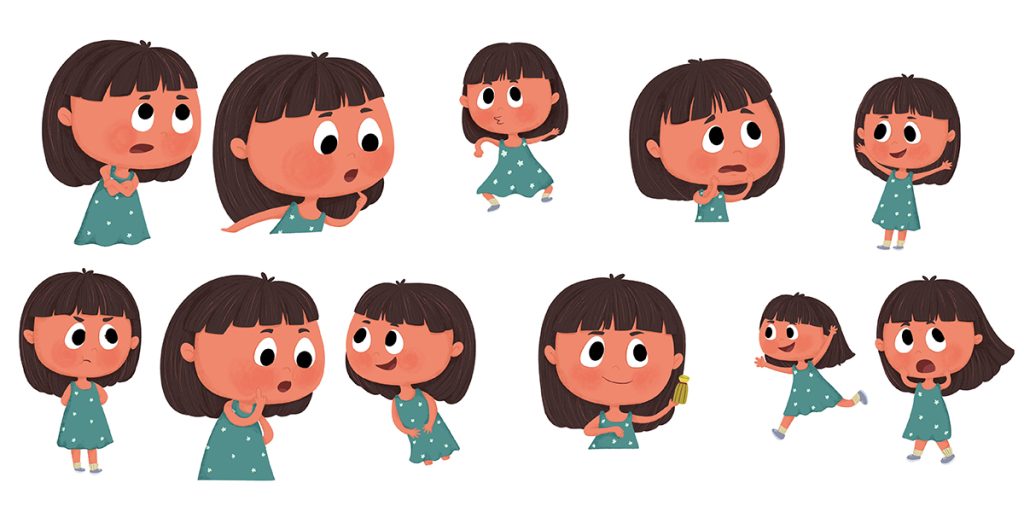Behind every memorable character from children’s book heroes to animated icons — lies a thoughtful design process. Character design isn’t just about drawing a face; it’s about visually expressing a story, a personality, and an emotion through artistic choices.
Whether you’re an illustrator, storyteller, or aspiring designer, understanding the basics of character design shapes, colors, and style choices is essential for creating characters that connect with audiences and stand out on the page.
In this guide, we’ll explore how these three core elements work together to form the foundation of every great design.
The Role of Shapes in Character Design
Shapes are the building blocks of visual storytelling. Before adding color or detail, a designer starts with basic forms—circles, squares, and triangles to define a character’s personality and energy.
Circles: Softness and Approachability
Circular shapes suggest friendliness, warmth, and innocence. That’s why so many beloved children’s characters are built with rounded forms. Soft edges make them appear kind, safe, and approachable.
Squares: Strength and Stability
Square-based designs give a sense of reliability, confidence, and power. They’re often used for characters who are strong, protective, or grounded—think of superheroes or fatherly figures. The straight lines and right angles communicate structure and control.
Triangles: Energy and Danger
Triangles evoke sharpness, speed, and tension. Villains and mischievous characters often have triangular silhouettes because pointed shapes visually suggest danger and unpredictability.
Understanding shape language helps a designer communicate personality instantly, even before color or detail is added.
Also Read:The Difference Between Character Design and Character Development
How Colors Bring Characters to Life
Once the shapes establish form, color brings emotion and storytelling to the surface. Color psychology is a vital part of character design—it influences how audiences feel about a character at first glance.
Warm Colors: Energy and Emotion
Colors like red, orange, and yellow are associated with warmth, excitement, and positivity. These are often used for energetic or passionate characters who bring life to a scene.
For example:
- Red conveys confidence, love, or aggression.
- Orange represents creativity and enthusiasm.
- Yellow suggests happiness, optimism, and curiosity.
Warm colors tend to attract attention, making characters feel alive and expressive.
Cool Colors: Calmness and Mystery
Blues, greens, and purples communicate calmness, intelligence, or mystery. They’re perfect for wise mentors, introverted heroes, or mystical beings.
- Blue represents loyalty and peace.
- Green can mean growth, nature, or envy.
- Purple evokes magic, royalty, or imagination.
Neutral and Monochrome Tones
Neutral colors like black, gray, or brown add balance and realism. They can suggest maturity, mystery, or practicality, depending on the design.
The key to successful color use lies in balance. Too many hues can confuse the eye; too few may feel flat. A professional character designer chooses a palette that supports the personality, mood, and setting of the story.
Style Choices: Defining Your Visual Identity
Style determines the visual tone and audience connection of your characters. It’s how you decide the level of detail, realism, and exaggeration that best fits your story.
Realistic Style
In realistic character design, proportions, textures, and anatomy follow real-world logic. This style works well in graphic novels, concept art, or video games that aim for immersive realism. However, it requires strong technical drawing skills and attention to lighting and anatomy.
Cartoon or Stylized Design
Cartoon and stylized characters focus on exaggeration, simplicity, and expression. Shapes are bolder, features are amplified, and emotions are easier to read. This style dominates children’s book illustration, animation, and storytelling for younger audiences because it feels lively and approachable.
Hybrid or Semi-Realistic Style
This approach combines realism with stylization think Disney or Pixar. Characters are believable yet still whimsical, allowing emotional storytelling without losing artistic creativity.
The style you choose should always serve your story’s purpose. A whimsical children’s tale calls for soft, colorful characters, while an epic fantasy might demand detailed armor and dramatic shading.
Combining Shapes, Colors, and Style
The most successful characters blend all three fundamentals shape, color, and style into one harmonious design. Each element complements the others to reinforce the character’s identity.
For example:
- A kind, nurturing grandmother might use rounded shapes, warm pink tones, and a soft illustrative style.
- A cunning antagonist could feature angular shapes, sharp contrasts, and a bold graphic style.
- A curious child hero may have medium proportions, bright primary colors, and a cartoon-like appearance for relatability.
Common Mistakes to Avoid
Even skilled artists can stumble into design traps. To make your character look professional and polished:
- Avoid overcomplicating details simplicity improves recognition.
- Don’t ignore silhouette clarity a good character should be identifiable even in shadow.
- Ensure color contrast for readability.
- Keep consistency the same style and proportions should appear throughout all poses and expressions.
Good character design is about clear communication, not complexity.
Conclusion
Character design is both an art and a language. Shapes communicate energy, colors express emotion, and style connects with the intended audience. When these elements work together, they transform a flat drawing into a living, breathing personality.
Whether you’re designing for a children’s storybook, a comic, or an animation, remember: the goal isn’t just to make your character look good it’s to make them feel real.
At The Rainbow Stories, we specialize in custom character design that blends shape theory, color harmony, and unique style to help authors bring their stories to life beautifully and meaningfully.







